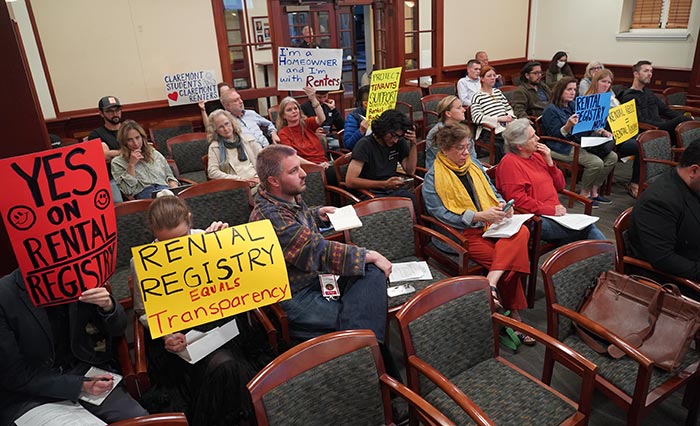City works to climb out of pension funding hole
Claremont is $50.8 million in the hole with funding its retirement pensions, but the city says it is chipping away at the debt.
That information comes from Claremont Finance Director Adam Pirrie, who said in an email the shortfall represents the “unfunded liabilities,” or money that is owed to a person for their retirement plan under CalPERS, short for the California Public Employees Retirement System.
The unfunded liabilities come from a number of factors, including a “lower than expected” assumed rates of return on investments as well as a change in assumptions on how long retirees live and when they retire.
“The most recent experience study showed that retirees were living longer and retiring earlier than previously expected,” Mr. Pirrie said.
What this means, he added, is that CalPERS is paying retirees for a longer period of time than anticipated, which had led to higher unfunded liabilities and contribution rates.
The problem isn’t concentrated in Claremont. Multiple stories from media outlets across the state have declared a pension crisis, with the Santa Cruz Sentinel in particular deeming it a “train wreck” in a February 7 editorial.
CalPERS survives on a steady diet of returns on investments and contributions from city employees and cities themselves. CalPERS recently changed the rate of return assumption from 7.5 percent to 7 percent, Mr. Pirrie said, which has also increased the unfunded liabilities and driven up contribution rates.
One way to close the gap is shifting the onus of employee contribution from the city to the employee. Before the financial crisis, Mr. Pirrie said, it was common for cities to pay that contribution, which usually hovered around seven to nine percent of payroll depending on the retirement plan.
But when the financial crisis hit, the city council negotiated with employees to have them start paying their share, Mr. Pirrie said.
“Claremont employees are now responsible for paying the full amount of the employee share, which has reduced the city’s pension costs by approximately $1 million per year,” Mr. Pirrie said.
The city is also negotiating lower-tier retirement plans for newer hires with a reduced benefit plan. This is in line with what the state is doing—in 2013, the state introduced a “third tier” retirement benefit plan that increased the retirement age and slashed the benefits, Mr. Pirrie said.
“All employees who are new to the CalPERS system must be enrolled in these third tiers,” Mr. Pirrie said.
Those changes are reflected in the benefit formulas from the current memoranda of understanding with Claremont city employee groups. For “classic members,” meaning members who were hired before March 19, 2012, their plan is to receive 2.5 percent of their highest salary per year as a pension starting at age 55 for the first tier, and 2 percent at 55 for classic members hired after March 19 for the second tier.
For third tier employees in Claremont, meaning “new members” who were hired after January 1, 2013, they city provides 2 percent at age 62.
For safety employees, such as sworn police officers, the first and second tiers stand at 3 percent at age 50 and 3 percent at age 55, respectively. Third tier safety employees will get 2.7 percent at 55.
The city council has been making discretionary payments toward the debt by authorizing additional payments of $100,000 per year since 2012, Mr. Pirrie added. The city also made $2.6 million in additional payments in years where there was a noticeable surplus in the general fund, he said.
Starting in 2017, the city tried to save money by prepaying contributions. The city receives a discount if it pays its annual dues earlier in the year, and that tactic has saved about $100,000, Mr. Pirrie said. It’s a strategy the city aims to continue in the coming years.
Despite all of this, Mr. Pirrie sees the unfunded liability as an issue that will stay with Claremont for years to come. The city is working in the debt into its 2018-2020 budget, which should be unveiled to the council in the next few months.
He described the contribution increases as “significant,” and amount to $600,000 per year from the city’s general fund.
Factor this into the overall city budget shortfalls of $1.4 million for 2018-2019 and $2.1 million in 2019-2020, plus the millions of dollars the city owes in attorney fees from the failed bid to take over the water system, and there is a tough road ahead.
The ongoing CalPERS situation should loom heavily over current contract negotiations with city employee organizations. Mr. Pirrie said employees “have certainly become aware of the magnitude of the pension issue of the negotiation process,” but could not comment further as negotiations are ongoing.
Two closed-session meetings with employee organizations were held on March 13 and March 27. City spokesperson Bevin Handel said negotiations could take several months.
CalPERS anticipates pension plans to be fully funded within the next 30 years, but Mr. Pirrie says its actions in trying to right the ship place a burden.
“From a budgetary perspective, this will continue to place a strain on the city’s budget for the foreseeable future,” Mr. Pirrie said.
—Matthew Bramlett
news@claremont-courier.com








0 Comments